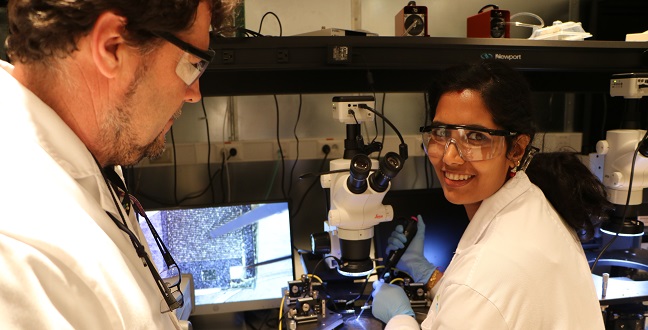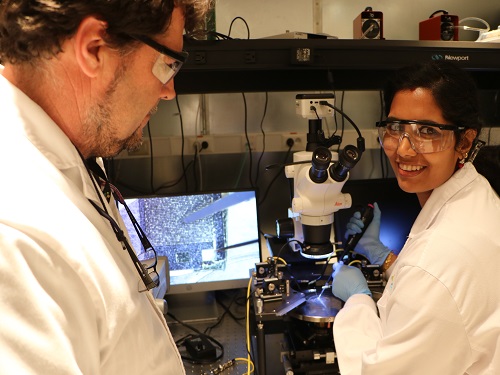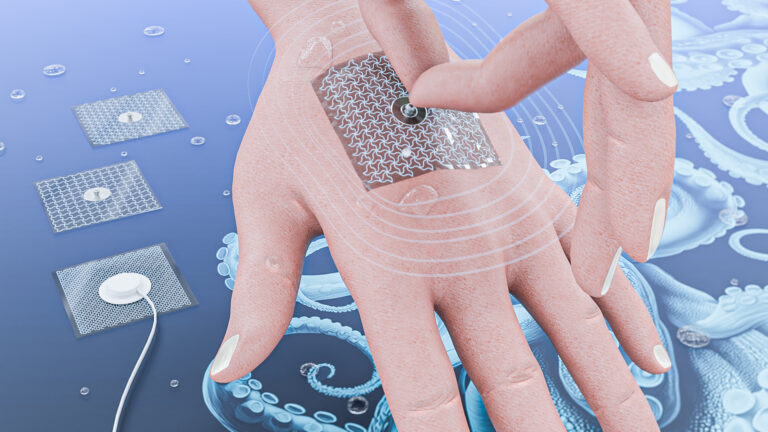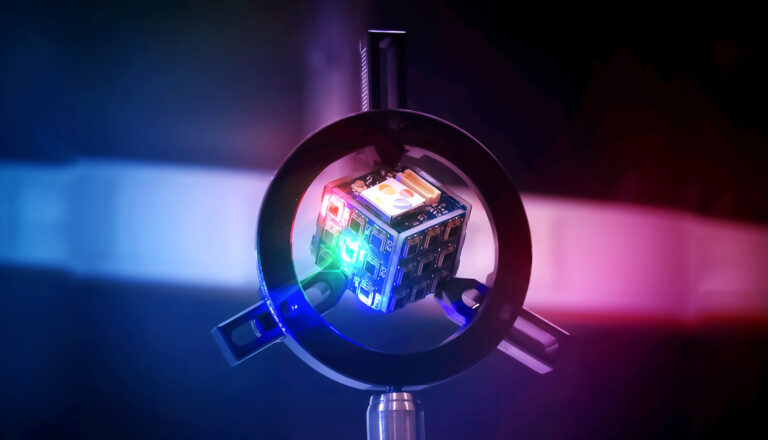Electrical Engineering
Miniature flexible sensor to detect heart disease
A new biosensor made of laser-etched electrodes on a gold-coated polymer may provide an effective and cost-efficient way to assess heart disease risk.


Shilpa Sivashankar and Ulrich Buttner depositing CRP on their biosensor chip and testing it under the microscope using an electrical probe station.
© 2015 KAUST
A flexible device that can be used as a biosensing tool has been developed by researchers at KAUST.
The low-cost method for manufacturing the tool involves sputtering a 600-nanometer layer of gold on to a small sheet made of a common plastic known as polyethylene terephthalate (PET)1. The gold layer is etched by laser to make parallel gold electrodes across the PET surface. The sheet is then coated to insulate and protect it from moisture. This gold interdigitated electrode array (IDE) was made in an inexpensive setup without the use of clean room facilities.
Antibodies specific to C-reactive protein (CRP), a protein made in the liver in reaction to tissue injury and inflammation, were then spread in a thin film across the IDE and attached to the surface of tiny beads, allowing more sites for the CRP to connect to.
Postdoctoral fellow Shilpa Sivashankar from the Computer, Electrical and Mathematical Science and Engineering Division, said this was the first time that beads were used to improve the performance of gold IDEs.
The team, led by principal investigator Khaled Salama, found that the sensor was able to quantify various amounts of CRP in serum. When the CRP interacted with the antibody, a change of capacitance was detected that increased with higher levels of CRP.
Salama pointed to the example of commonly used biosensors, such as pregnancy tests and diabetic monitoring devices. “Having access to cheap, easy-to-use sensors is important,” he said.
“If we can extend the range of devices to include other biomarkers, we could help improve the healthcare spectrum. There is still room to improve the miniaturization and sensitivity of detection of various biomarkers that are known to be associated with certain diseases,” he added.
Research has shown that CRP serum concentrations can be used to assess the risk for cardiac disease where CRP concentrations above 3mg per liter of blood indicate a high risk.
“The hope is to have these devices used in the field or at the point of care directly,” noted Salama.
The team has filed to patent their flexible capacitive sensor. They also have seed funding to explore its use as a gas sensor.
“Similar to biomarkers, there are chemical materials that are sensitive and selective to specific gases. Coating our sensor with these materials should allow us to detect volatile organic gases that may be hazardous,” explained co-author Ulrich Buttner, a KAUST research scientist.
References
- Sivashankar, S., Sapsanis, C., Buttner, U. & Salama, K.N. Flexible low-cost cardiovascular risk marker biosensor for point-of-care applications. Electronics Letters 51, 1746–1748 (2015).| article
You might also like

Computer Science
Sweat-sniffing sensor could make workouts smarter

Electrical Engineering
New tech detects dehydration by touching a screen

Electrical Engineering
A new interface for efficient electronics

Electrical Engineering
Artificial neurons enable neuromorphic computing with light

Electrical Engineering
Narrow-linewidth lasers bring low-noise answer

Electrical Engineering
Octopus suckers inspire sticky medical patch

Electrical Engineering
Powering the future of the Internet of Things

Computer Science



